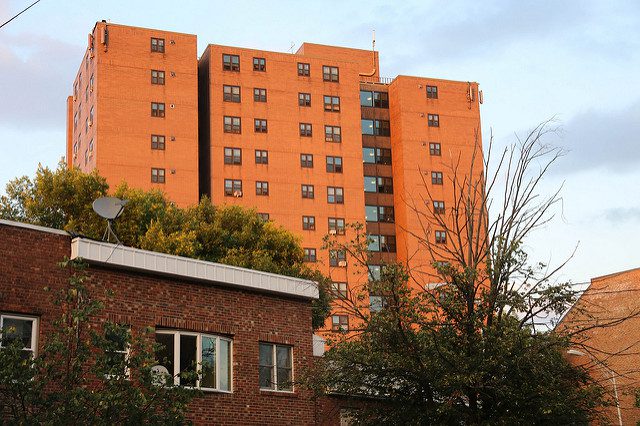Rent Control Under Siege
By the time you read this, rent control ordinances throughout Massachusetts will have been saved or abolished depending on the result of a statewide referendum that appeared on the November 8th ballot.
If Mass. voters approved Question 9, local rent control laws and rent grievance procedures will be abolished and unrestricted evictions as well as unlimited rent increases would be allowed. The Mass. condo conversion law would be weakened and the rights of communities to choose their own housing programs would be undermined. Over 200,000 tenants would face new risks of eviction and displacement.
Working hard to save rent control is the Save Our Communities Coalition of over twenty diverse groups including the Mass. Tenants Organization, the local chapters of the National Lawyer’s Guild, United Steelworkers Association, the Gray Panthers, the United Auto Workers, the Gay and Lesbian Labor Activists and many civic, political and labor groups. Their activities have been endorsed by the American Association of Retired People, the Mass. Assoc. of CDCs, the Mayors of Boston and Cambridge and Congressman Barney Frank.
If Question 9 was approved, it will have been a testament to the wealth and power of the Mass. real estate industry.
Squatter Groups Makes Gains
Inner City Press/Community on the Move (ICP), a neighborhood group based in the South Bronx – whose efforts were featured in an article in the May/June 1994 issue of Shelterforce – signed separate CRA agreements with First Fidelity Bancorp and Natwest after protesting the bank’s acquisition applications. First Fidelity agreed to lend $5 million a year for three years to residents and businesses in the Bronx and set up a $100,000 microloan fund for very small businesses and affordable housing projects. In addition, First Fidelity agreed to expand the delineation of its service area. Natwest, which also signed a commitment with ICP, agreed to open a branch in the South Bronx, expand its lending area, fund a small-business loan program, and assist low-income families in converting abandoned buildings into affordable housing.
The agreement come as part of ICP’s “second wave” of CRA challenges. Two years ago, ICP challenged the Bank of New York for “its refusal, up to that time, to include the Bronx, Harlem and Brooklyn in its delineation.” In addition to CRA activities, ICP is in the process of setting up a community development loan fund. For more information, contact ICP’s executive director, Matthew Lee, at 718-716-3540.
While Poverty Continues to Grow
According to the Census Bureau’s annual poverty report, released Oct. 6, poverty in the U.S. rose to 15.1 percent of the population last year, up from 14.8 percent in 1992. A total of 39.3 million people lived below the 1993 poverty level of $14,763 for a family of four. The current rate is the highest since the 15.2 percent rate in 1983.
The New York Times reported that median household income declined by $300 to $31,241 during 1993, when adjusted for inflation. More than 1 million people in the U.S. dropped below the poverty line during the year. Children, who make up 27 percent of the total population, account for 40 percent of the poor. Poverty in rural areas was higher at 17.2 percent than in metropolitan areas at 14.6 percent. Blacks had the highest poverty rate at 33.1 percent, compared with 30.6 percent for Latinos, 15.3 percent for Asians and Pacific Islanders and 12.2 percent for whites.
While average per capita earnings were up by 1.8 percent, most of the increase went to the wealthiest, with the top fifth of households earning 48.2 percent of the nation’s income, and the bottom fifth earning just 3.6 percent.
A number of causes are seen in the trend toward greater inequality, including the shift from a manufacturing to a service economy, increased international competition, decline in union activity and erosion of the minimum wage. Labor Secretary Robert Reich commented, “America is in danger of splitting into a two-tiered society. This is not anyone’s idea of progress.”
Poverty level increased in most states from 1992 to 1993. In California, the 1992 rate was 16.4 percent; in 1993 it grew to 18.2 percent. The increase in poverty directly affects the rate of homelessness and near homelessness.
LA Mayor Proposes Homeless Camp
On Oct. 14, the Associated Press reported that Los Angeles Mayor Richard Riordan proposed fencing in a four- to six-block area just east of downtown and building a center where up to 800 people could shower. There would be 50 beds, but most people would sleep on a lawn. Drug counseling would be available. Vans would transport people there on a voluntary basis.
“We are not going to allow people to camp on the streets at will,” said Don Spivack, director of operations for the Los Angeles Community Redevelopment Agency. “So we feel it’s very fair to give them another option.”
The plan has since been scaled back by the Mayor and is now being reviewed by two city committees.
and One Radio DJ Advocates Putting “Homeless People to Sleep Like Dogs”
A Los Angeles radio station KFI talk show host Emiliano Lamon claimed that on his way to work the morning of July 9, 1994, he had the revelation of calling for “putting homeless people to sleep like dogs.”
On Sept. 29, local homeless advocates were told by the KFI General Manager that he would not intervene with what a talk show host says, if he or she can “rationally defend it.” Finally, the advocates were told that it was not a matter of right or wrong, but of ratings.
The Los Angeles Coalition to End Homelessness demanded that Lamon apologize, that he invite homeless and formerly homeless people to appear on his program and that KFI management disassociate itself from Lamon’s violent and hateful statement, but not his right to say it.
To date, the Los Angeles Coalition to End Homelessness has not received an apology.
Is this a kinder and gentler West Coast?
“So, You Won the Lottery, Now What?”
On Sept. 17, 1994, the always helpful New York Times ran in its “How They Do It” column a feature many of us will, no doubt, find really, really useful. Let’s say, you win a lottery. Now that you’ve got lots of money, you want to make sure you don’t fritter it all away. Have some fun, put a few dollars away for a rainy day and invest. Using the real life story of Californian Lotto winner Jess S. Razo, a retired postal worker, and his family, the Times showed us all how the Razos were able to take $30,000 and save $75,000 over 10 years in investing in low-income housing tax credits. By our calculations, that’s a 25 percent return per year. Pretty good solution to the housing crisis.
Homelessness? I Don’t See It.
Apparently, Nobel Laureate Gary S. Becker doesn’t think there’s much of a homelessness crisis. In the Sept. 12 issue of Business Week, he extols the virtues of Christopher Jencks’ recent book, The Homeless, which “debunks” the myth of millions of homeless Americans originally perpetrated on a gullible nation by Mary Ellen Hombs and Mitch Snyder in their book, Homelessness in America: A Forced March to Nowhere.
The extent of homelessness is far less than we’re led to believe for two reasons, Becker believes. The first scientific reason is that he just can’t believe it, so it must be wrong: “[O]n the face of it, such an assertion – implying that more than 1 out of every 100 Americans in the 1980s had no place to live – simply isn’t credible.”
The second is based on the data and analysis used by Jencks. However, as research scientist Kim Hopper points out in the July/August 1994 issue of Safety Network, Jencks’ data is based on “point-in-time” studies, which only show how many people are homeless at a given time. He does not indicate how many people were homeless over a period of time, like a year. Such “period prevalence” studies performed by a number of groups support the conclusion that millions of Americans have been homeless over the past year. And millions more are in danger of losing their homes.
Becker does concede that, no matter what the actual numbers, they doubled from the late-’70s to the mid-’80s and are still increasing. But that doesn’t bother him. What does seems to trouble him is that “[I]f early assertions about the incidence of homelessness had been examined [using Jencks’ methodology], Snyder and others could not have so badly misled the American public.”
And, one is led to imagine, by not being fooled into thinking there is a crisis of homeless, the doubling of homelessness in a period of less than 10 years would not have occurred. Do all economists make such little sense?





Comments